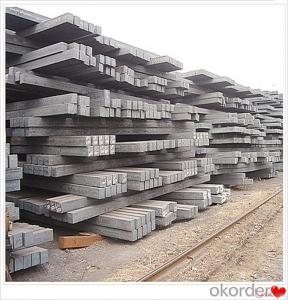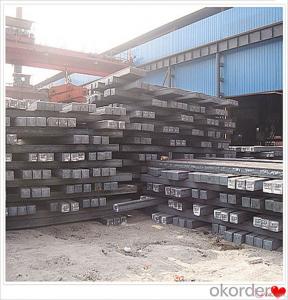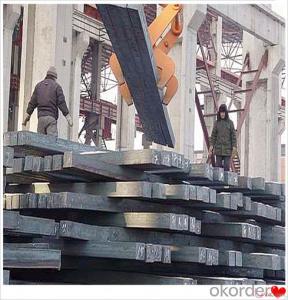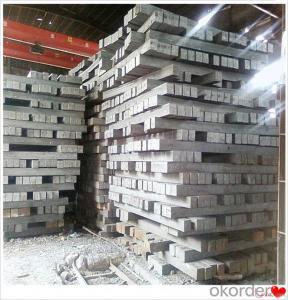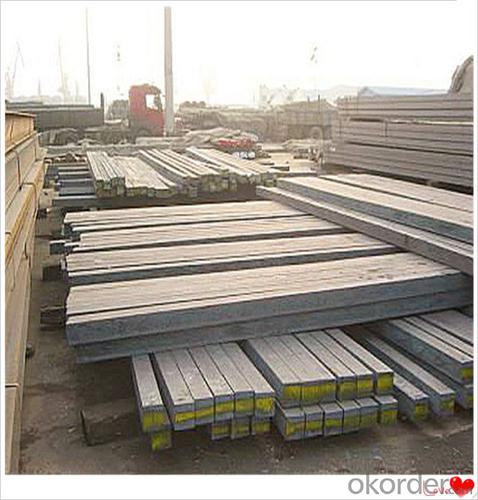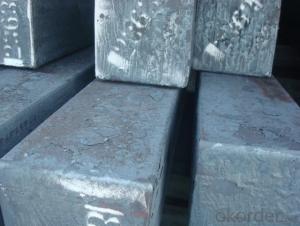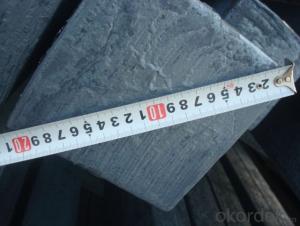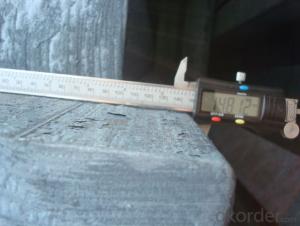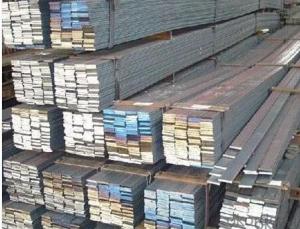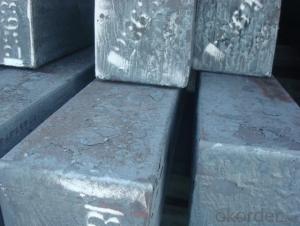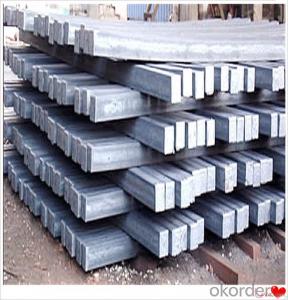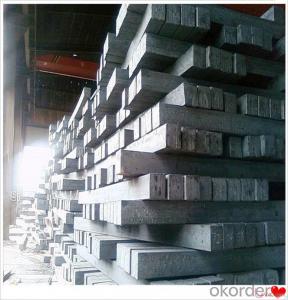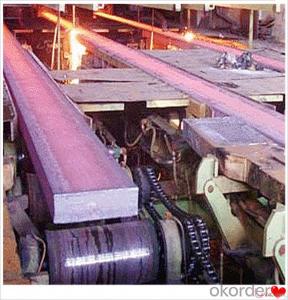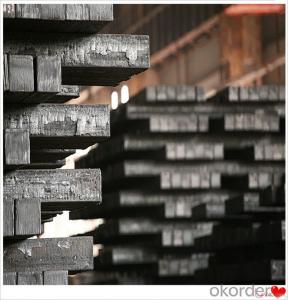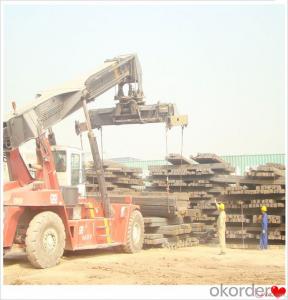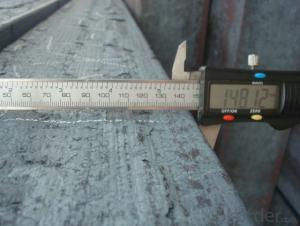Steel Billet for Rebar Steel Q235,Q255,Q275,Q345,3SP,5SP,20MnSi
- Loading Port:
- China main port
- Payment Terms:
- TT OR LC
- Min Order Qty:
- 20 m.t.
- Supply Capability:
- 200000 m.t./month
OKorder Service Pledge
OKorder Financial Service
You Might Also Like
Steel Billet for Rebar Steel Q235,Q255,Q275,Q345,3SP,5SP,20MnSi
Specification
Steel billet(ingot) by cogging or breakdown of semi-finished products, is the raw material of all kinds of steel mill. Billet section of square, round, flat, rectangular and abnormity of several kinds of, mainly related to the shape of rolled products.
CNBM Q235,Q275,Q345,3SP,5SP,20MnSi Billets Steel
Hot Rolled Steel Billets/ Mild Steel Bar/ Billet Steel
Specification (see below)
Standard: GB/JIS/ASTM
Size: 50*50mm-180*180mm
Length: 3-12mtrs or Customised
Steel material: Q235,Q255,Q275,Q345,3SP,5SP,20MnSi
Technique: Hot rolled
FOB Unit Ton Price $250-350 and Usually I will quote you CFR price.
MOQ: Usually 1000-10000MT/size
Shipment:By Container,Bulk Vessel
Packaging Details: bundles with steel strips or as customers's requirements
Delivery time: Usually within 30 days after the deposit/LC
Inspection:Third party inspection before loading.
Technical data
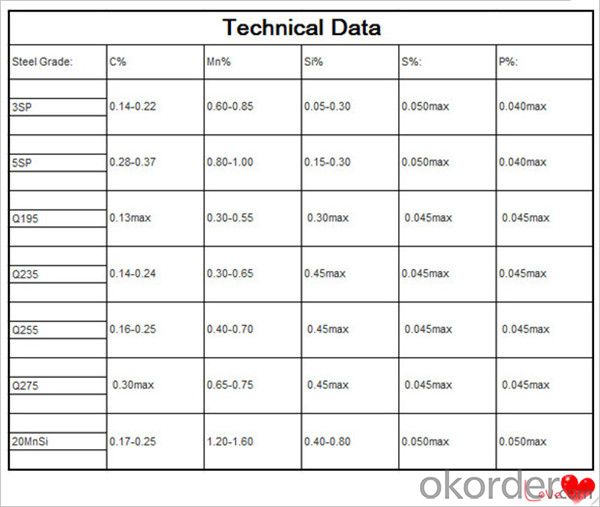
Feature Steel Billet
Rectangular billet continuous casting billet and mainly general carbon steel, low carbon low silicon cold-rolled material, high quality carbon structural steel, high strength low alloy steel, special steel, etc.
The billet is mainly divided into two kinds from the shape:
Slab: cross section width and height of the ratio of the larger, mainly used for rolling plate.
Billet: equal cross section width and height, or a huge difference, mainly used for rolling steel, wire rod. ,
Steel billets have distinct characteristics as compared with already furnished steel bars and products. Billets have a specific grain structure, which enables the metal to be processed more intricately. Steel billets are also known for their malleability and ductility, especially when exposed to varying temperatures during shaping and molding.
Packaging & Shipping
1. Packaging:
1) Small size: in bundles
2)Big size: in bulk
3)in plastic packing or as per customer requirement
2. Delivery time:
1) Normal size: within 7days send from warehouse directly
2) Special size: with 25-30days customer made for you
3. Trade terms:FOB/CFR/CIF
4. Shippment:
1) length:≤5.8m loaded in 20FT Container with 25-27tons
2) length:≤11.8m loaded in 40FT Container with 25-27tons
3) lengnth:≥12m shipped by bulk vessel, FILO terms
Steel Billet Images
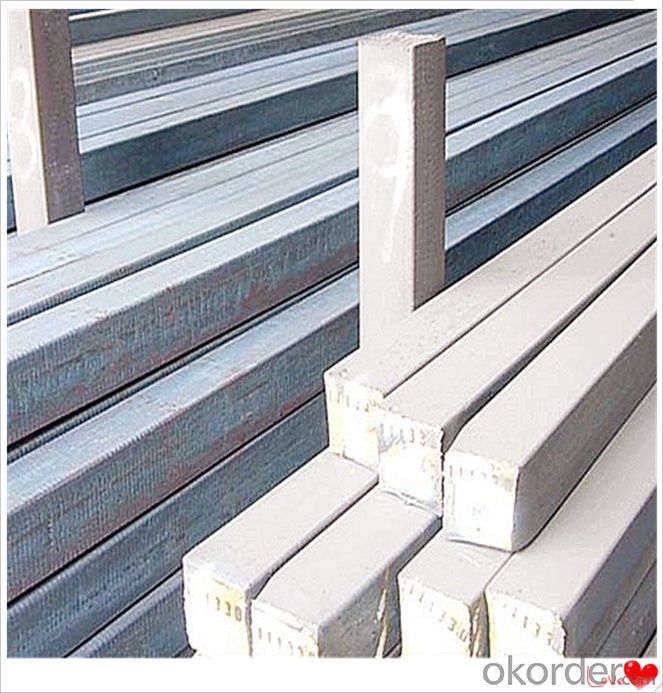
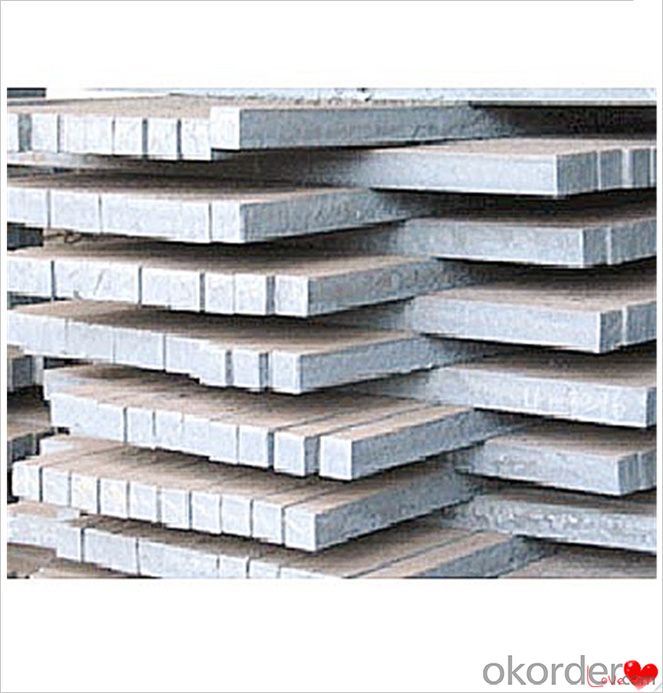
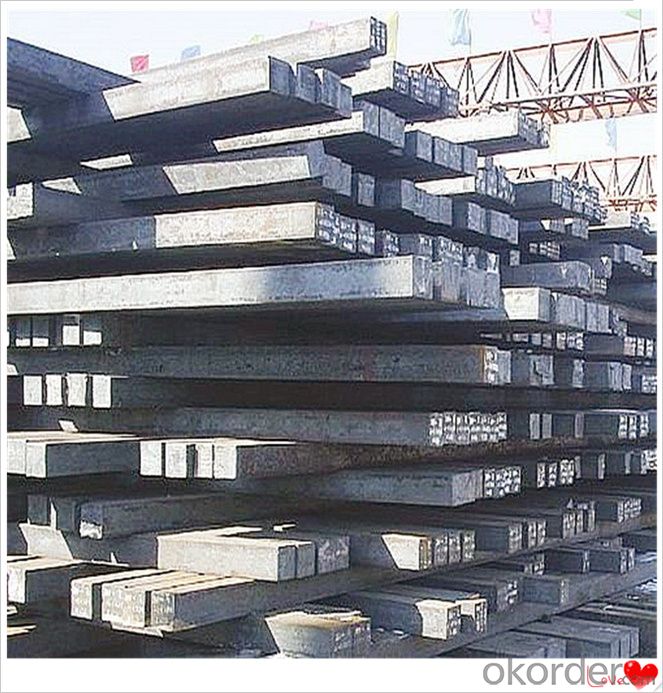
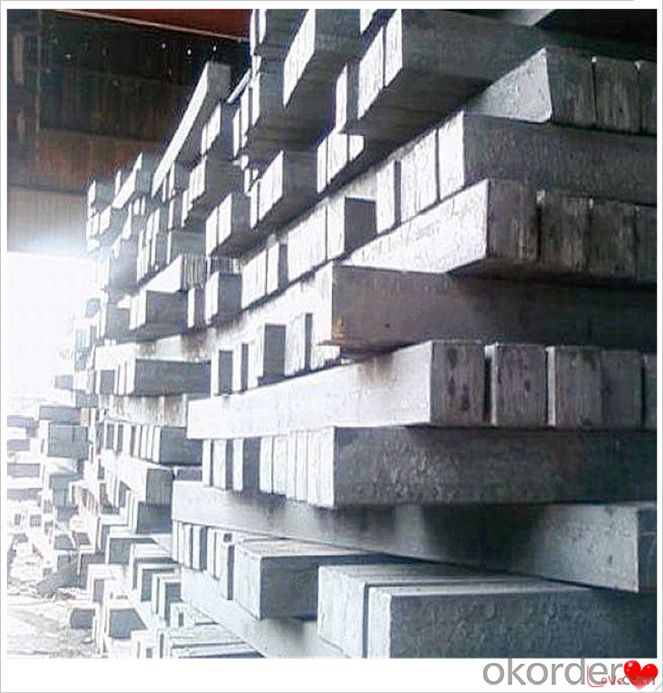
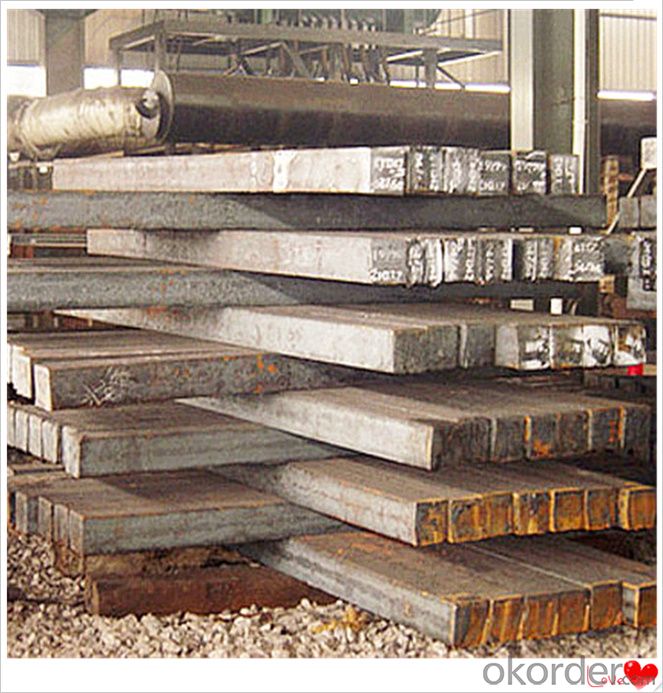
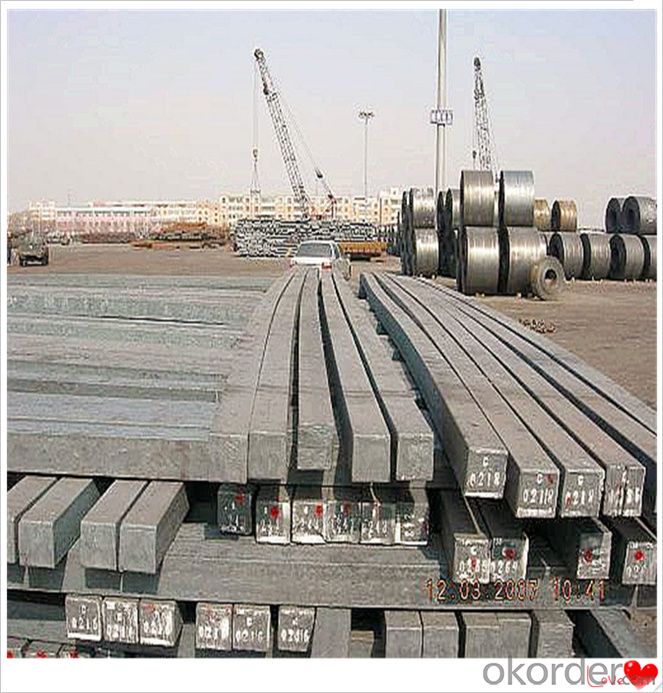
Processing
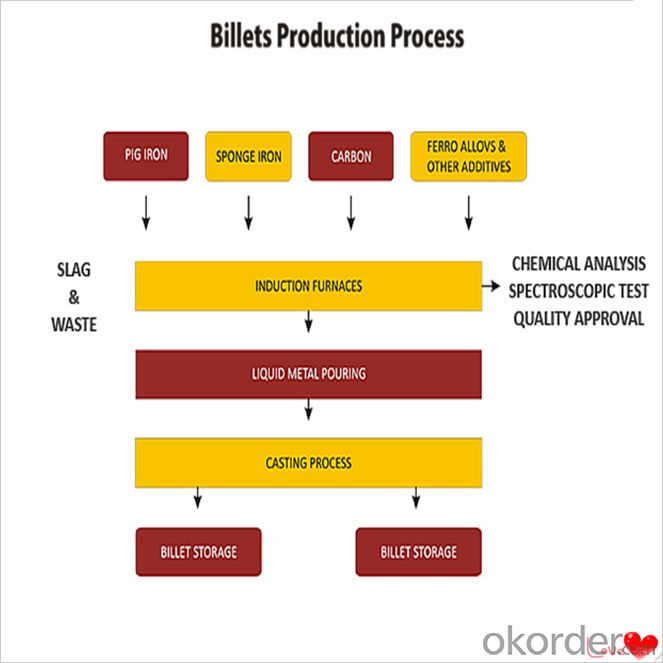
Usage-Billet Steel
Used for the plant, the bridge,shipment building high-rise building construction,lifting and transportation machinery, equipment manufracturing base building the support foundation pile manufacturing.
Billets, or ingots (as they sometimes referred to), are not of practical use until they have been formed into more functional shapes and sizes. While they have already been put in the furnace, they still require a series of shaping and molding procedures such as hot and cold working, milling and cutting before they are sold in hardware stores, or used for different applications. The unformed billets, however, can be used in striking currency such as coins and as reserves, similar to gold bars.
FAQ-Billet Steel
We have organized several common questions for our clients,may help you sincerely:
1) How about your company?
A world class manufacturer & supplier of castings forging in carbon steel and alloy steel,is one of the large-scale professional investment casting production bases in China,consisting of both casting foundry forging and machining factory. Annually more than 8000 tons Precision casting and forging parts are exported to markets in Europe,America and Japan. OEM casting and forging service available according to customer’s requirements.
2) How to guarantee the quality of the products?
We have established the international advanced quality management system,every link from raw material to final product we have strict quality test;We resolutely put an end to unqualified products flowing into the market. At the same time, we will provide necessary follow-up service assurance.
3) How long can we receive the product after purchase?
In the purchase of product within three working days, We will arrange the factory delivery as soon as possible. The pecific time of receiving is related to the state and position of customers.Commonly 7 to 10 working days can be served.
4)Do you have your own QC department?
Yes, we have, our QC department will inspect the goods during the process of mass production and after completion of production.
hot sale!!! Cast Steel Grades/ mild steel bar/ billet steel
(1): High quality steel with reasonable price.
(2): Wide excellent experiences with after-sale service.
(3): Every process will be checked by responsible QC which insures every product's quality.
(4): Professional packing teams which keep every packing safely.
(5): Trial order can be done in one week.
(6): Samples can be provided as your requirements.
- Q: What are the different forging methods used for steel billets?
- Steel billets can be forged using different methods, each with its own advantages and applications. Open Die Forging is a method where the steel billet is shaped between flat dies. This allows for flexibility in design and size, making it suitable for larger and more complex parts that require customization, like shafts, cylinders, and discs. Closed Die Forging, also known as impression die forging, involves shaping the steel billet within a set of dies that contain the desired shape. It is ideal for producing high-precision and complex parts with tight tolerances, such as gears, connecting rods, and crankshafts. Upset Forging is a method that involves increasing the cross-sectional area of the steel billet by compressing it between dies. This is commonly used for creating short-length parts like bolts, screws, and fasteners. Roll Forging uses cylindrical rolls to gradually shape the steel billet into the desired form. It is often used to produce long parts with a consistent cross-section, such as bars, rods, and shafts. Press Forging utilizes a hydraulic or mechanical press to shape the steel billet, providing greater control over the forging process. This method is often employed for manufacturing automotive components, aerospace parts, and tools. Isothermal Forging involves heating the steel billet and the dies to the same temperature, reducing the cooling effect during forging. This allows for greater control over the microstructure and mechanical properties of the final product, making it suitable for producing parts that require high strength and temperature resistance. Each forging method has its own benefits, allowing steel billets to be shaped into a wide range of products with varying complexity, size, and mechanical properties. The choice of forging method depends on factors such as the desired product, material properties, production volume, and cost considerations.
- Q: What is the role of steel billets in the construction of stadiums and arenas?
- Steel billets play a crucial role in the construction of stadiums and arenas as they are the primary raw material used to manufacture structural steel components. These billets are heated and shaped into various forms, such as beams, columns, and trusses, which provide the necessary support and framework for the overall structure. The high strength and durability of steel make it an ideal material to withstand the heavy loads and forces experienced in these large-scale facilities. Additionally, steel billets can be easily fabricated and assembled on-site, ensuring efficient construction and enabling the creation of complex designs and architectural features.
- Q: How are steel billets cast into shape?
- The process of continuous casting is used to shape steel billets. In this process, molten steel is poured into a copper mold that is cooled by water. The mold is in the shape of a billet, and as the steel is poured, it starts to solidify along the mold's walls. To ensure complete solidification, a water spray is employed at the bottom of the mold, rapidly cooling the steel. As the steel solidifies, it is continuously pulled out of the mold either by a set of rollers or a chain conveyor. Once the billet has solidified entirely, it is cut into desired lengths using a high-speed torch or saw. These cut billets are then transported to the next stage of the steel manufacturing process, such as rolling or forging, where they are further shaped into the final product. Continuous casting enables the production of steel billets with consistent cross-sectional shapes and sizes. This efficient process generates high-quality steel products while minimizing waste.
- Q: What is the lifespan of a steel billet?
- The lifespan of a steel billet can vary depending on several factors such as the quality of the steel, the conditions in which it is stored and used, and the specific application it is being used for. Generally, steel billets are designed to have a long lifespan and can be used for many years without significant degradation. Steel billets are typically made from high-quality steel that is specifically engineered to have excellent strength, durability, and resistance to corrosion. This ensures that the billet can withstand the rigors of various industrial processes and applications. In terms of storage and usage conditions, steel billets need to be stored in a dry and controlled environment to prevent moisture and other contaminants from causing rust or degradation. They should also be handled and transported carefully to prevent any physical damage that could compromise their integrity. The lifespan of a steel billet also depends on the specific application it is being used for. Some billets are used in high-stress applications such as construction, automotive manufacturing, or heavy machinery, where they may undergo significant wear and tear. In these cases, the lifespan of the billet can be shorter compared to less demanding applications. Overall, with proper care, maintenance, and adherence to recommended usage guidelines, a steel billet can have a long lifespan ranging from several years to decades. Regular inspections, maintenance, and replacement of worn or damaged billets are essential to ensure optimal performance and safety in various industries.
- Q: What are the main applications of steel billets?
- Steel billets are semi-finished products that are used in various applications across different industries. The main applications of steel billets include: 1. Construction: Steel billets are commonly used in the construction industry for the production of structural steel. They are used to manufacture beams, columns, and other load-bearing elements in buildings and infrastructure. Steel billets provide strength, durability, and high load-bearing capacity, making them ideal for construction projects. 2. Manufacturing: Steel billets are also used in the manufacturing industry for the production of various metal products. They are often used as raw materials for the manufacturing of pipes, tubes, rods, wires, and other metal components. Steel billets can be easily shaped and formed into different sizes and shapes, making them versatile for manufacturing purposes. 3. Automotive Industry: Steel billets are extensively used in the automotive industry for the production of various components and parts. They are used to manufacture engine parts, chassis components, suspension systems, and other critical automotive components. Steel billets offer excellent mechanical strength and heat resistance, making them suitable for demanding automotive applications. 4. Machinery and Equipment: Steel billets are also utilized in the machinery and equipment industry. They are used to manufacture gears, shafts, bearings, and other components that require high strength and durability. Steel billets can withstand heavy loads and provide excellent resistance to wear and tear, making them essential for machinery and equipment manufacturing. 5. Energy and Oil Industry: In the energy and oil industry, steel billets are widely used for the production of pipes and tubes. They are utilized in the construction of pipelines for transporting oil, gas, and other fluids over long distances. Steel billets provide the required strength, corrosion resistance, and pressure containment necessary for such applications. Overall, steel billets are crucial in various industries due to their excellent mechanical properties, versatility, and ability to be shaped into different forms. Their applications range from construction and manufacturing to automotive, machinery, and energy industries, contributing to the development and growth of multiple sectors.
- Q: What are the different types of steel billet cutting tools?
- There are several different types of steel billet cutting tools available, each designed for specific purposes and applications. Some of the most common types include: 1. Bandsaw: This type of cutting tool uses a continuous loop of toothed blade to cut through steel billets. Bandsaws are versatile and can be used for both straight and curved cuts. 2. Circular saw: Circular saws feature a toothed blade that rotates in a circular motion to cut through steel billets. They are known for their speed and efficiency, making them a popular choice for large-scale cutting operations. 3. Abrasive cut-off saw: These tools use a high-speed rotating abrasive disc to cut through steel billets. Abrasive cut-off saws are ideal for cutting through thick and hard materials quickly. 4. Plasma cutter: Plasma cutters use a high-velocity jet of ionized gas to melt and cut through steel billets. They are known for their precision and ability to cut through thick materials with ease. 5. Waterjet cutter: Waterjet cutters use a high-pressure jet of water mixed with abrasive particles to cut through steel billets. This type of cutting tool is highly accurate and does not generate heat, making it suitable for cutting heat-sensitive materials. 6. Laser cutter: Laser cutters use a high-powered laser beam to melt and vaporize steel, creating a precise and clean cut. Laser cutting is known for its high level of accuracy and versatility. These are just a few examples of the different types of steel billet cutting tools available. The choice of tool depends on factors such as the type and thickness of the material being cut, the desired level of precision, and the specific application requirements.
- Q: What is the role of steel billets in the production of steel bars?
- Steel billets are the primary raw material used in the production of steel bars. They are semi-finished steel products that are heated and then shaped into solid bars through a process called rolling. The billets provide the necessary starting material for the production of steel bars, which are widely used in construction, manufacturing, and various other industries.
- Q: What are the different surface finishes available for alloy steel billets?
- There are several different surface finishes available for alloy steel billets, depending on the specific requirements and applications. Some of the common surface finishes include: 1. Hot rolled: This is the most common surface finish for alloy steel billets. It is achieved by rolling the steel billet at a high temperature, which results in a rough and scaled surface. 2. Cold drawn: This surface finish is achieved by pulling the steel billet through a die at room temperature. It provides a smooth and polished surface, with improved dimensional accuracy and surface quality. 3. Peeled: In this process, a layer of material is removed from the surface of the steel billet using a peeling tool. It results in a smooth and shiny surface finish, with improved surface quality and dimensional accuracy. 4. Ground: This surface finish is achieved by grinding the surface of the steel billet using abrasive wheels or belts. It provides a smooth and uniform surface finish, with improved surface quality and dimensional accuracy. 5. Turned: In this process, the steel billet is rotated against a cutting tool, which removes material from the surface and creates a smooth and polished finish. It is commonly used for high precision applications where a smooth surface finish is required. 6. Polished: This surface finish is achieved by polishing the steel billet using abrasive compounds and buffing wheels. It provides a mirror-like finish, with improved aesthetic appeal and corrosion resistance. It is important to select the appropriate surface finish based on the specific requirements of the application, such as dimensional accuracy, surface quality, aesthetic appeal, and corrosion resistance.
- Q: How are steel billets used in the manufacturing of industrial machinery parts?
- Steel billets possess unique properties and versatility, making them indispensable for the production of industrial machinery parts. These semi-finished steel products are typically cast in square or rectangular shapes and serve as the foundational material for critical components like gears, shafts, pistons, and others. To facilitate manipulation and shaping, the first step involves heating the steel billets to a specific temperature. Once heated, they undergo a process known as hot rolling, where they are passed through rollers to decrease their cross-sectional area and increase their length. This not only enhances the steel's strength and durability but also refines its microstructure, resulting in improved mechanical properties. Following hot rolling, further processing takes place through machining operations such as cutting, drilling, milling, and grinding. These operations ensure precise dimensions and specifications required for specific machinery parts, enabling seamless integration into the overall machinery assembly. The high strength, toughness, and resistance to wear and tear of steel billets make them highly sought after in the manufacturing of industrial machinery parts. Their exceptional machinability allows for intricate designs and patterns, ensuring optimal functionality and performance. Additionally, steel billets can be easily welded, enabling the joining of multiple parts to create robust structures. In summary, steel billets play a vital role in the manufacturing of industrial machinery parts. By providing a strong, durable, and versatile starting material, they enable the creation of precise and reliable components essential for the smooth operation of industrial machinery in sectors such as manufacturing, construction, and transportation.
- Q: What are the different types of steel billets?
- There exists a variety of steel billets, each possessing its own distinct attributes and applications. Among them, the most commonly encountered types are: 1. Carbon Steel Billets: Constructed from iron and carbon, these billets are widely employed due to their exceptional strength and durability. Consequently, they find utility in numerous sectors, including construction, automotive, and machinery manufacturing. 2. Alloy Steel Billets: By incorporating diverse alloying elements such as chromium, nickel, or manganese into carbon steel, alloy steel billets exhibit improved properties such as enhanced strength, hardness, and resistance to corrosion. Thus, they are frequently employed in industries necessitating high-performance materials, such as aerospace, oil and gas, and power generation. 3. Stainless Steel Billets: These billets are manufactured with a high chromium content, resulting in superior resistance to corrosion and oxidation. They are typically employed in applications where hygiene, durability, and aesthetic appearance are of utmost importance, such as food processing, medical equipment, and architectural structures. 4. Tool Steel Billets: Engineered to possess remarkable hardness, wear resistance, and heat resistance, tool steel billets are widely utilized in the fabrication of cutting tools, molds, and dies for various industries, including automotive, manufacturing, and construction. 5. Electrical Steel Billets: Comprised of low carbon steel with unique magnetic properties, electrical steel billets find application in the production of electrical equipment, such as transformers, motors, and generators. Their significance lies in their ability to minimize energy loss and exhibit high magnetic permeability. 6. High-speed Steel Billets: These billets are alloyed with elements such as tungsten, molybdenum, and cobalt, which enable them to retain their hardness and strength under high temperature conditions. They are extensively employed in the manufacture of cutting tools necessary for high-speed cutting operations, including drills, milling cutters, and taps. These examples represent only a fraction of the diverse range of steel billets available. The selection of a particular steel billet hinges upon the specific requirements of the application, such as strength, durability, corrosion resistance, or specialized properties essential for specific industries.
Send your message to us
Steel Billet for Rebar Steel Q235,Q255,Q275,Q345,3SP,5SP,20MnSi
- Loading Port:
- China main port
- Payment Terms:
- TT OR LC
- Min Order Qty:
- 20 m.t.
- Supply Capability:
- 200000 m.t./month
OKorder Service Pledge
OKorder Financial Service
Similar products
Hot products
Hot Searches
Related keywords

